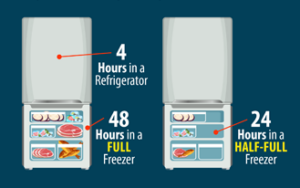- Trust your instincts and take immediate action if you perceive any danger.
- Refrain from activities that may produce sparks. If possible, avoid travel, as blowing dust and debris can create hazardous road conditions.
- Oxygen-dependent people should have enough spare bottles to get through Sunday, or should consider staying with family, friends or at a hotel outside planned outage areas.
- Smoke alarms may start chirping intermittently because the backup batteries are low and should be replaced.
- Do not use a gas stove to heat a home, do not use outdoor stoves indoors and keep generators outside in a well-ventilated area away from windows.
- Turn off or disconnect appliances and other equipment in case of a momentary power “surge” that can cause damage.
- If you need to open your garage door when the power is out:
-
- Find the emergency release cord. It is usually red and dangling down from the mechanism on the roof of your garage.
- Pull the emergency release cord down and toward the door opener unit, or reach up and pull the lever at the top of the emergency release cord to disconnect the opener.
- Manually lift the door until you hear or feel it connect again.
- Secure the door.
Food Safety
- Keep refrigerator and freezer doors closed.
- If the doors stay closed, food will stay safe for up to:
- 4 hours in a refrigerator.
- 48 hours in a full freezer; 24 hours in a half-full freezer.
- If the power has been out for 4 hours, and a cooler and ice are available, put refrigerated perishable foods in the cooler. To keep them at 40°F or below, add ice or a cold source like frozen gel packs.
After:
- Never taste food to determine if it is safe to eat. When in doubt, throw it out.
- Throw out perishable food in your refrigerator (meat, fish, cut fruits and vegetables, eggs, milk, and leftovers) after 4 hours without power or a cold source like dry ice. Throw out any food with an unusual odor, color, or texture.
- Check temperatures of food kept in coolers or your refrigerator with an added cold source. Throw out food above 40°
- If you have an appliance thermometer in your freezer, check to see if it is still at 40 °F or below.
- You can safely refreeze or cook thawed frozen food that still contains ice crystals or is at 40 °F or below.


Comments are closed.